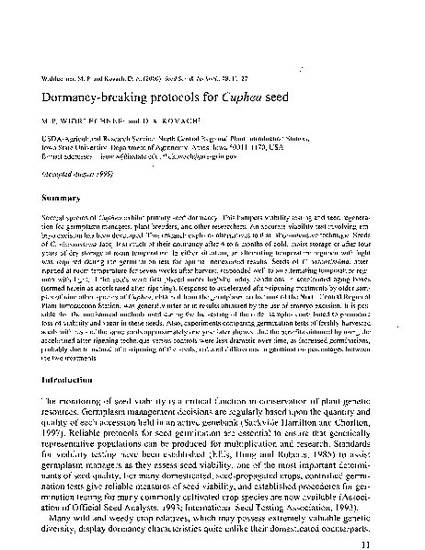
Article
Dormancy-breaking protocols for Cuphea seed
Seed Science and Technology
Document Type
Article
Disciplines
Publication Version
Published Version
Publication Date
1-1-2000
Abstract
Several species of Cuphea exhibit primary seed dormancy. This hampers viability testing and seed regeneration for germplasm managers, plant breeders, and other researchers. An accurate viability test involving embryo excision has been developed. This research explores alternatives to that labour-intensive technique. Seeds of C. viscosissima lost much of their dormancy after 4 to 6 months of cold, moist storage or after four years of dry storage at room temperature. In either situation, an alternating temperature regimen with light was required during the germination test for optimal nonexcised results. Seeds of C. viscosissima, after-ripened at room temperature for seven weeks after harvest, responded well to an alternating temperature regimen with light, if the seeds were first placed under high-humidity conditions in accelerated aging boxes (termed herein as accelerated after-ripening). Response to accelerated after-ripening treatments by older samples of nine other species of Cuphea, obtained from the germplasm collections of the North Central Regional Plant Introduction Station, was generally inferior to results obtained by the use of embryo excision. It is possible that the mechanical methods used during the harvesting of the older samples contributed to premature loss of viability and vigour in these seeds. Also, experiments comparing germination tests of freshly-harvested seeds with tests of the same seeds approximately one year later showed that the benefits obtained by using the accelerated after-ripening technique versus controls were less dramatic over time, as increased germinations, probably due to natural after-ripening of the seeds, reduced differences in germination percentages between the two treatments.
Rights
Works produced by employees of the U.S. Government as part of their official duties are not copyrighted within the U.S. The content of this document is not copyrighted.
Language
en
File Format
application/pdf
Citation Information
M. P. Widrlechner and D. A. Kovach. "Dormancy-breaking protocols for Cuphea seed" Seed Science and Technology Vol. 28 Iss. 1 (2000) p. 11 - 27 Available at: http://works.bepress.com/mark_widrlechner/112/

This article is from Seed Science and Technology 28 (2000): 11.